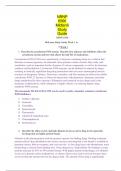NRNP
6566
Midterm
Study
Guide
NRNP 6566
Mid-term Study Guide Week 1 to 5 Week 1 1. Describe the cytochrome P450 system. Describe how inducers and inhibitors affect the cytochrome system and how that affects the half-life of medications.
Cytochromes P450 (CYPs) are a superfamily of enzymes containing heme as a cofactor that function as monooxygenases. In mammals, these proteins oxidize steroids, fatty acids, and xenobiotics, and are important for the clearance of various compounds, as well as for hormone synthesis and breakdown. Cytochrome P450 enzymes can be inhibited or induced by drugs, resulting in clinically significant drug-drug interactions that can cause unanticipated adverse reactions or therapeutic failures. Fluoxetine, sertraline, and fluvoxamine are believed to inhibit cytochrome P450 2C because of observed interactions with phenytoin, diazepam, and other drugs metabolized by these enzymes. Rifampicin and isoniazid are key drugs used in the treatment of tuberculosis, while rifampicin is highly effective in inducing hepatic, drug metabolic P450 enzyme.
The mnemonic SICKFACES.COM can be used to easily remember common cytochrome P450 inhibitors.
1.Sodium valproate.
2.Isoniazid.
3.Cimetidine.
4.Ketoconazole.
5.Fluconazole.
6.Alcohol & Grapefruit juice.
7.Chloramphenicol.
8.Erythromycin.
2.Describe the affect on low and high albumin levels on active drug levels especially for drugs that are highly protein bound.
Albumin is the plasma protein with the greatest capacity for binding drugs. Binding to plasma proteins affects drug distribution into tissues, because only drug that is not bound is available to penetrate tissues, bind to receptors, and exert activity. As free drug leaves the bloodstream, more
bound drug is released from binding sites. Some drugs have a high affinity for binding to serum proteins and may be 95% to 98% protein bound. With highly protein bound drugs, low albumin levels (as in protein-calorie malnutrition, or chronic illness) may lead to toxicity because there are fewer than the normal sites for the drug to bind. The amount of free drug is significantly increased in that case. Competition for binding sites is one important way that drugs might interact. If a patient is using two highly protein bound drugs at the same time, there will be competition for binding sites on the albumin. The drug with the greatest affinity for the albumin will bind, and is thought to disrupt the normal ratio of free to bound drug for the second medication. As a result, the second medication will be more available to distribute to the site of action and potentially cause side effects.
3.Describe ways to lessen the hepatic first pass effect
Some drugs, such as propranolol or enalapril, undergo significant metabolism during a single passage through the liver. This is called the first-pass effect. When drugs are highly susceptible to the first-pass effect, the oral dose needed to cause a response will be significantly higher than the intravenous dose used to cause the same response. Alternative routes of administration, such as suppository, intravenous, intramuscular, inhalational aerosol, transdermal, or sublingual, avoid the first-pass effect because they allow drugs to be absorbed directly into the systemic circulation.
4.Be able to calculate creatinine clearance using the Cockgraft Gault equation
The Cockcroft-Gault formula for estimating creatinine clearance (CrCl) should be used routinely
as a simple means to provide a reliable approximation of residual renal function in all patients with CKD. The formulas are as follows:
-CrCl (male) = ([140-age] × weight in kg)/(serum creatinine × 72)
-CrCl (female) = CrCl (male) × 0.85
5.Describe what determines the frequency of drug administration
Plasma concentration data collected from this type of study is plotted against time and analyzed
in order to understand the behavior of a specific drug in the body. This type of pharmacokinetic
data, collected from average adults, is the basis for determining dose, dosing intervals, and limitations on the safe use of a drug. Absorption, distribution, metabolism, and elimination or ADME.
6.Be familiar with the Beers criteria and how to use it
The 2019 update uses the five criteria outlined in 2015; these include medications that should typically be avoided in most older patients, medications that should be avoided in older patients
with certain conditions, medications that should be used with caution because of benefits that may offset risks, medication interactions, and changes in dosing based on kidney function. In addition to these criteria, decisions about medications should take into account a variety of factors, including stopping medications when they are no longer beneficial.
7.Describe factors that affect absorption, distribution, metabolism and excretion
The rate and extent of absorption depends on the route of administration, the formulation and chemical properties of the drug, and physiologic factors that can impact the site of absorption. The acid environment or presence of food in the stomach, the solubility and other chemical properties of the drug, and the effect of the initial exposure to metabolic processes in the liver may all reduce the amount of drug that reaches the systemic circulation after oral administration, thereby reducing the bioavailability of the drug. Patient variables that can affect distribution




